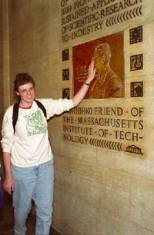Freshman Gabrielle L. Frame snacked on a bagel and yogurt while she pored over her notes on an Eastman Lobby bench Monday morning before departing for the Johnson Athletics Center to take the final exam in Introductory Biology.
As she left, she paid the traditional homage to the George Eastman plaque in front of Room 6-120, hoping it would result in good luck on the test. Generations of MIT students have rubbed Eastman's nose to a high sheen, many of them en route to an exam.
"Some people believe the luck has been rubbed out of the nose," said Frame, who is from Omaha, Neb. "That's why I'm rubbing the ear."
Frame said upper class students had passed down the tradition orally. Senior Amanda M. Bligh of Contoocook, N.H., heard about it on a campus tour prior to matriculation.
"It's not just for good luck," said Bligh, a mechanical engineering major. "It's also for the inversion of bad luck."
Bligh rubbed the nose without thinking as she strolled toward the Infinite Corridor Monday. She said she had rubbed the nose whenever she found herself in the vicinity of Room 6-120 for the past four years.
"I guess it brought me good luck," Bligh said. "I'm graduating."
Eastman, founder of the Eastman Kodak Co., contributed $7.5 million to MIT anonymously from 1912 to 1920, with the Institute raising $5.5 million in matching funds. The identity of the school's benefactor, known as "the mysterious Mr. Smith," became known in 1920 when Eastman appeared at a dinner to present the final grant.
Eastman, who did not attend MIT, explained why he chose the Institute in a letter to Richard C. Maclaurin, MIT's president from 1909 to 1920. "When my first contribution to MIT was made, I had been carefully looking over the field for some time," he wrote in 1916. "I formed the opinion that there was no other place where a large sum of money could be invested with more effectiveness ... I feel very strongly that the progress of this country is to be affected by the men turned out of MIT."
The plaque was installed in 1934. The tradition followed shortly. How it developed is as mysterious as the donor's identity was for all those years.
"The nose was shiny when I was an undergraduate," said William J. Hecht (S.B. 1961), vice president and CEO of the MIT Association of Alumni and Alumnae. Hecht admitted he did not join the crowd in front of the plaque when he was a student. "By the time finals rolled around, I usually was in so much trouble that nothing would help," he quipped.
A version of this article appeared in MIT Tech Talk on May 22, 2002.






